Attitude over Altitude
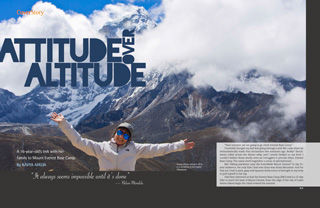
(Left) Kavya Ahuja, taking it all in, to a backdrop of the mighty Himalayas.
A 16-year-old’s trek with her family to Mount Everest Base Camp.
“It always seems impossible until it’s done.”
— Nelson Mandela
“Next summer, we are going to go climb Everest Base Camp.”
I honestly thought my dad was going through a midlife crisis when he enthusiastically made that declaration two summers ago. Really? Shockwaves rolled across the dinner table, and I nearly choked on my food. I couldn’t believe those words, even as I struggled to process them. Everest Base Camp. The name itself engenders a sense of astonishment.
Me? Hiking anywhere near the formidable Mount Everest? In my 15-year existence, the only hike I had ever done was Stone Mountain. And for that too, I had to pant, gasp, and squeeze every ounce of strength in my body to pull myself to the top.
Dad then informed us that the Everest Base Camp (EBC) trek is a 12-day hike to reach the base of Mount Everest, from the edge of the city of Lukla, where hikers begin the climb toward the summit.
I was overwhelmed by the enormity of the enterprise––could I really do it? But then, a frisson of excitement danced over me. This would be an achievement, and I had never achieved anything before other than finishing a whole show on Netflix in a week. My mind played out a little dream sequence of people cheering my name in a room filled with banners proclaiming “Kavya Ahuja––Base Camp Champ” embellished on them. An eager smile unfurled across my face as I said that one word my dad was looking for: “Yes!” (My younger brother, on the other hand, groaned in despair, “Can’t we just be a normal family and go to Hawaii?”)
When I said yes to the trip, I overlooked one thing: my complete lack of athleticism. And now, here we were, deciding to go on one of the world’s hardest treks. Every Saturday and Sunday, at 7 a.m., my father dragged my mother, brother and me out of bed to some natural park or other for a hike. I absolutely despised it. What was the point of walking for hours just staring at trees?
But then one weekend, just like that, my aversion turned into passion. I was sitting on the top of a mountain, sweat glistening on my forehead and pain trickling into my legs. As the sun dipped low, causing an explosion of warm colors in the sky, I realized that I could do this forever. My hikes became longer. My legs became stronger.
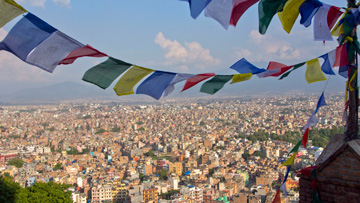
“Kathmandu may have not been the main attraction of this trip, but its cultural richness overwhelmed me.”
Soon, May 26, 2017, the last day of my sophomore year and the day of our flight to Nepal arrived. When we landed in Kathmandu, the sun shot down rays of heat that surrounded us from all directions. My inflight sweatshirt and tights seemed to morph into a second layer of skin, as we strained to spot Dawa, our guide for the trip. My eyes scanned the crowd until I found a sign with the word “Ahuja” on it, held by an energetic-looking Nepali. Dawa was one of those people who make you feel welcome in one glance. He had a round face, a wide smile, and a head sparsely covered with hair. His eyes crinkled, and a Cheshire cat grin emerged on his face as he located our disheveled selves. Our luggage was flung in a car, and we were whisked away to explore the magnificent city of Kathmandu.
Narrow streets embellished with colorful triangle-shaped prayer flags covered the whole city, and roads were lined with rows of shops selling jackets, souvenirs, and Nepali crafts. As we strolled through the streets, the sounds, sights, and smells inundated my senses. Kathmandu may have not been the main attraction of this trip, but its cultural richness overwhelmed me—a memory I will always treasure.
To begin the trek, you must fly to the Tenzing-Hilary airport in a city called Lukla, described as one of the most dangerous airports in the world. Since the airport is at a high altitude, the visibility must be crystal clear for flight landings, or flights have to be cancelled. There was a rush of anticipation in the air on that June day at the Kathmandu domestic airport as hikers with large backpacks twiddled their thumbs, hoping for a flight.
We were four of those hikers. I was uneasy and restless over this uncertainty, even as I prayed for clear weather. My tense body tried to find a comfortable position in the black metal chairs as we waited…and waited…and waited. Turned out, dark black clouds were closing in on Lukla.
Just when I thought we wouldn’t make it that day, a short hefty man appeared yelling across the airport, in a thick accent, about helicopter rides. My dad’s eyes glanced at all of ours silently asking the one question lingering in all our heads, “Should we take a helicopter instead?” No prizes for guessing what we decided! So, there I was sitting in a waiting area and watching my brother Kanav munching on a veggie sandwich from the airport while a vivid yellow helicopter waited to escort us to our destination. (Kanav likes to call this trip, “How one sandwich can ruin a lifetime experience.” But more on that later.)
Flying on a helicopter in the Himalayas is a surreal experience. The turbulent sounds of the wings spinning penetrated our ears as the helicopter lifted straight up like a mosquito buzzing in the air. The stunning green mountains of Nepal seemed to embrace us, and the buildings dropped away like colorful Lego pieces as we soared higher. If you squinted, the small trails carved on the mountains became visible.
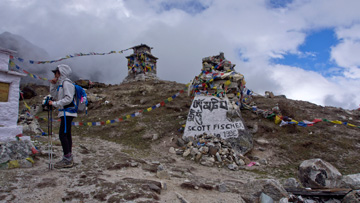
(Left) At the grave of a hiker who died while climbing Everest.
As my eyes traced the tiny paths covering the mountains, I worried. One specific memory from the day we were exploring Kathmandu resurfaced. At a shop for hiking gear, we met an experienced climber who had arrived from Camp III on Mount Everest. Sorrow filled his eyes as he described his experience of almost reaching the summit but falling short. When we told him our plans to reach Base Camp and pressed him for advice, he replied, “Yeah man, even I found Base Camp challenging. It’s funny that you have to pay money for this torture!”
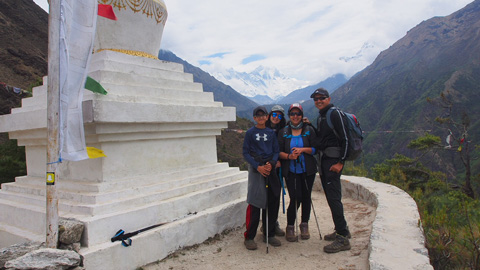
(Left) The Ahuja family at a Buddhist stupa, with Mount Everest in the background.
The helicopter landed and it was time to get going on the hardest undertaking of my life. The gate at the end of the first city, Lukla, signified the official beginning of the EBC trek. From the gate, you could see the rocky rugged path continuing for miles and miles. We hiked around six to eight hours every day from one city to another, and at night we stayed at lodges. Lodges—also known as teahouses—were simple accommodations along the way, providing a small bedroom, food, and a bathroom. The lodges featured intricate Nepali decorations and bright colors. In fact, all the cities were decorated based on the rich local culture. There were bright prayer flags that seemed to line the sky, gigantic black rocks with Nepali script painted on, huge colorful Buddhist prayer wheels for spinning, and enormous monasteries.
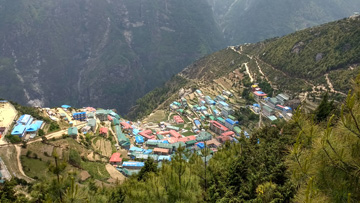
(Left) “This beautiful place opens up like the seating area of an amphitheater,” is how Kavya describes the city of Namche Bazaar.
One town that enchanted me was Namche Bazaar. This beautiful place opens up like the seating area of an amphitheater. Varying levels of red, blue, and orange buildings make the city vividly stand out against the backdrop of the massive mountain ranges.
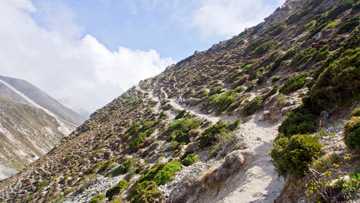
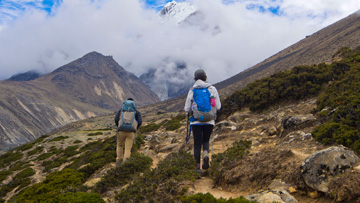
(Left and below) The 12-day trek offered unending trails, massive mountain vistas, and a total elevation gain of close to 10,000 feet.
The path of the hike was mostly uphill and rocky. At some points, it felt as if my whole body was screaming as fiery pain burned down my limbs. At times, the hikes seemed never-ending and every step felt useless. But all this would be forgotten when my eyes took in the vast spaces before me. Words cannot describe how beautiful Nepal’s mountains are.
We had started in Lukla at an elevation of about 8,792 feet, and our final destination, the EBC, was at 18,192 feet. The hike is usually one that many first timers do in groups. But this was off-season so it was just our family with our guide Dawa. We did see many other small groups hiking as well.
The first days of the hike took us through green clad mountains, rushing blue rivers, and tall, stately suspension bridges with their edges wrapped in prayer flags.
Soon, the landscape changed to massive gray mountains capped with pearly white snow, trails of blue icy water trickling down. When we crossed a tree line, the land turned barren and flat, encircled by peaks. Nepal has eight out of the ten highest mountains in the world. Gigantic rocks filled the path, and I felt like an astronaut exploring a new world.
A hidden gem on this trip was the people we met. Nepalis are the most hardworking, kind, and humble humans I have met. Their smiles warmed us. Passing by on trails, they greeted us with a gentle “Namaste.”
I met a lodge owner who was raising money to help local kids go to school. She traveled to different countries to raise awareness, and get funds so one more child could receive an education. During our travels, my father lost his camera lens, and a Nepali porter brought it right back when he could very well have sold it elsewhere for a profit.
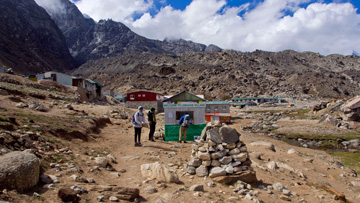
Hiker checkpoint at Lobuche (16,000 ft), a small settlement near Mount Everest.
And then, there were other hikers we met. They offered helpful tips, and we bonded over our common love of hiking. I met people from different countries, and I learned so much from them. There was a Swede who had moved to the Khumbu region, also known as Everest region, to help set up a future recycling center and museum to promote cleanliness around Everest. We also met an American working for an environment conservation organization that monitors glacial changes. He had flown in from the U.S. for the sole purpose of changing the memory card of one of the cameras mounted near a glacier! The EBC trek is just a path of rocks, but it’s the people who come here that make it special.
But back to that sandwich my brother ate at the airport in Kathmandu. Alas, he ended up with food poisoning and had to stay behind. My mom, who was so passionate about the trip, made the biggest sacrifice, staying with him. My mother and brother ended up going back to Namche Bazaar, where they waited out six days until my father and I completed the trek. We had never expected that one of us would fall ill. But people do become unwell, mostly from altitude sickness, a condition that arises at high altitudes where the body does not get sufficient oxygen, leading to a host of complications and, sometimes, even death. The fear of altitude sickness stalked me all through the trip, and to prevent it, I walked slowly and drank massive amounts of water.
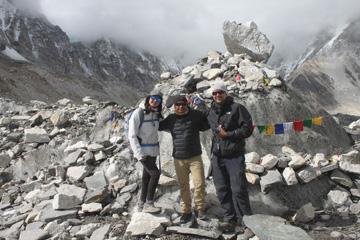
(Left) Kavya and her dad, with their guide, Dawa (center).
The final hike to EBC was a fulfilling event. My father and I had grown so accustomed to the rigors of our daily hikes that we had completely forgotten what our normal lives were like. But that day, there was more than regular excitement. The hike was filled with huge boulders, and I often felt like I was going to slip and fall. Snowy white mountains enveloped us as we slowly climbed the trail. The mountains seemed so close that I felt I could touch them and let the cold of the snow shiver up my arm. The actual Base Camp is a little underwhelming. It is just a rock covered with prayer flags, but when you look beyond, the beauty of the Khumbu Glacier is an alluring vision. Arriving there, I was filled with an inner glow as I realized that this was more than just an achievement. It was an experience of a lifetime, studded with precious memories.
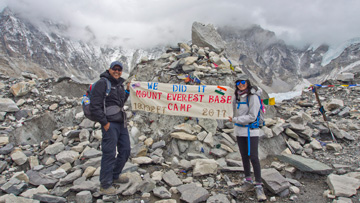
Well-earned smiles at the culmination of a challenging adventure.
Above all, I learned that truly, anything is possible. So, dear reader, go on an adventure, make memories, and have experiences you will cherish. It can be trekking up Mount Everest, running a marathon, exploring your own community, or anything you imagine. Don’t doubt your own potential even for a second, because you can do anything you set your mind to. Go make the impossible, possible.
Kavya Ahuja is a Junior at Lambert High School. She now aspires to climb the summit of Mount Everest in 10 years.
Enjoyed reading Khabar magazine? Subscribe to Khabar and get a full digital copy of this Indian-American community magazine.
blog comments powered by Disqus










